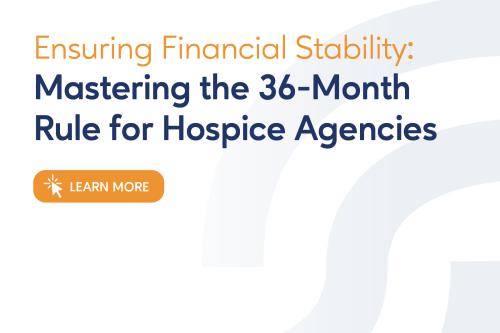Mastering the 36-Month Rule: Strategies for Hospice Agencies to Maintain Cash Flow Stability

Understanding the 36-Month Rule for Hospice Agencies
The Centers for Medicare & Medicaid Services (CMS) recently implemented the 36-Month Rule, impacting hospice agencies nationwide. Similar to the existing rule for home health agencies, this regulation requires re-enrollment with Medicare upon a change in majority ownership within 36 months of initial enrollment or a previous ownership change. While re-enrollment ensures patient care continuity and adherence to Medicare standards, it can lead to temporary interruptions in billing and reimbursement, potentially causing cash flow disruptions for hospice agencies.
In this comprehensive guide, we’ll explore 7 ways hospice agencies can navigate the 36-Month Rule without compromising financial stability. Here’s what hospice providers need to know to protect their revenue streams and stay compliant with Medicare hospice regulations:
7 Key Strategies to Mitigate Cash Flow Challenges Under the 36-Month Rule
The 36-Month Rule mandates that hospice agencies re-enroll with Medicare when experiencing a majority ownership change within 36 months of initial enrollment or a previous ownership transition.
Let’s dive into essential strategies to maintain financial stability:
1. Plan Ownership Changes Carefully
Timing is Key
To minimize disruptions, avoid making ownership changes within the 36-month window if possible. Evaluate the financial and operational impacts of such transitions and plan accordingly.
Effective hospice ownership transition planning is crucial for maintaining Medicare compliance and ensuring uninterrupted patient care. Hospice agencies can minimize disruptions and protect financial stability by strategically timing ownership changes.
Action Items:
- Review Ownership Plans: Regularly assess your agency’s ownership structure and consider the timing of any potential changes.
- Strategize Transitions: Develop a strategic plan for the 36-month rule and its implications.
2. Streamline Re-enrollment for a Smooth Process
Re-enrollment for hospices requires comprehensive documentation and adherence to Medicare guidelines. Preparing in advance ensures a smoother process.
Mastering the Medicare re-enrollment process is essential for hospice agencies navigating the 36-Month Rule. A well-organized approach to documentation and regular updates can significantly reduce the risk of cash flow interruptions in hospice Medicare billing.
Action Items:
- Documentation Checklist: Create and maintain a checklist of all required documents for re-enrollment.
- Regular Updates: Keep records up-to-date to avoid last-minute scrambles during ownership changes.
3. Notify Stakeholders
Clear Communication
Informing staff, stakeholders, and financial partners about potential re-enrollment and its implications is crucial for maintaining trust and operational continuity. Transparent communication about the 36-Month Rule and its potential impact is key to maintaining stakeholder trust in hospice management. Keeping all parties informed helps ensure a smoother transition and continued operational success.
Action Items:
- Communication Plan: Develop a plan to inform stakeholders about the 36-month rule and potential re-enrollment scenarios.
- Stakeholder Briefings: Regularly update stakeholders on any changes or developments related to ownership transitions.
4. Build a Financial Buffer with Strong Cash Reserves
Financial Buffer
Setting aside funds to cover potential cash flow gaps during re-enrollment can mitigate financial strain.
Robust hospice financial management, including maintaining adequate cash reserves, is critical for weathering potential reimbursement delays during the re-enrollment process. A strong financial foundation helps hospices maintain quality care despite regulatory challenges.
Action Items:
- Analyze Cash Flow Needs: Assess your agency’s financial needs and determine an appropriate reserve amount.
- Establish a Reserve Fund: Create and maintain a financial buffer to ensure continuous operations during re-enrollment.
5. Schedule Regular Consultations and Conduct Compliance Reviews
Expert Guidance
Engaging with legal and financial professionals can help navigate the complexities of the 36-month rule and ensure compliance with Medicare hospice regulations. Regular consultations with hospice compliance experts and reviews help agencies navigate complex rules like the 36-Month Rule, ensuring continued eligibility for Medicare reimbursement.
Action Items:
- Professional Consultation: Schedule regular consultations with legal and financial advisors.
- Compliance Reviews: Conduct periodic reviews to ensure adherence to Medicare requirements and avoid potential issues.
6. Develop a Contingency Plan to Address Unexpected Issues
Be Prepared
A well-thought-out contingency plan can provide a roadmap for dealing with unexpected delays or issues during re-enrollment. Proactive hospice management includes preparing for potential cash flow disruptions due to regulatory changes. A comprehensive contingency plan is essential for maintaining financial stability and ensuring continuous patient care.
Action Items:
- Draft a Contingency Plan: Outline steps to take in case of cash flow interruptions or re-enrollment delays.
- Alternative Funding Sources: Identify and secure temporary financial support options as part of your contingency plan.
7. Implement an Internal Audit System
Regular Audits
Internal audits help identify potential issues early, ensuring your agency remains compliant and prepared for re-enrollment. It can be unsettling when Medicare delivers an Additional Documentation Request (ADR) or one of Medicare’s numerous types of contractors informs your organization that you’ve been selected for a hospice Medicare audit.
Action Items:
- Audit Schedule: Establish a regular internal audit schedule to review compliance and financial stability.
- Issue Resolution: Address any issues identified during audits promptly to avoid disruptions.
36-Month Rule – Key Takeaways
By carefully planning ownership changes, preparing for re-enrollment, notifying stakeholders, maintaining cash reserves, consulting advisors, developing a contingency plan, and implementing an internal audit system, hospice agencies can effectively navigate the 36-Month Rule and avoid cash flow interruptions. These proactive steps in hospice revenue protection ensure continuous operations and financial stability during ownership transitions.
How SimiTree Can Help
Our expert consultants offer tailored solutions to ensure your agency remains compliant and financially stable. From hospice billing to ADRs/audits/appeals, SimiTree provides the hospice Medicare compliance support you need to thrive in today’s challenging healthcare environment.
Need expert guidance on the 36-Month Rule or other hospice management challenges? Contact our team today or visit our website (www.simitree.com) for comprehensive support in optimizing your hospice agency’s operations and compliance strategies.

